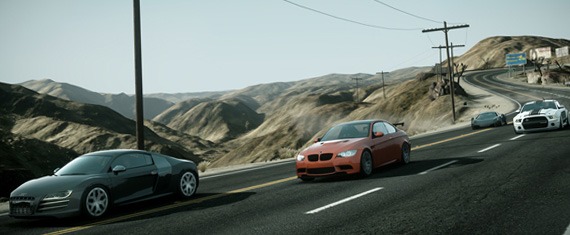 I’ve been a fan of the Need for Speed series since the Xbox 360 launch, when the console’s launch-window entry taught us all how fun evading the cops could be at ridiculously high speeds. The Need for Speed series has undergone some changes in the past five years, flipping between arcade- and sim-style racing and hopping between cop-evasion and race-driven gameplay. The latest entry, Need for Speed: The Run, evolves the series yet again, with players occasionally getting out of their car to race, jump and quick-action-button-press their way through scripted scenes. Although it sounds odd on the surface, the change in pace is actually welcome, particularly when you consider how the racing elements have changed as well. The result is one of the most white-knuckled racing games I’ve played, albeit occasionally one of the most frustrating.
I’ve been a fan of the Need for Speed series since the Xbox 360 launch, when the console’s launch-window entry taught us all how fun evading the cops could be at ridiculously high speeds. The Need for Speed series has undergone some changes in the past five years, flipping between arcade- and sim-style racing and hopping between cop-evasion and race-driven gameplay. The latest entry, Need for Speed: The Run, evolves the series yet again, with players occasionally getting out of their car to race, jump and quick-action-button-press their way through scripted scenes. Although it sounds odd on the surface, the change in pace is actually welcome, particularly when you consider how the racing elements have changed as well. The result is one of the most white-knuckled racing games I’ve played, albeit occasionally one of the most frustrating.
Need for Speed: The Run is organized essentially like a rally race, with players cruising as fast as they can across the United States of America while a timer tracks their overall progress as well as their rank in the 200-person competition. The “track,” as it were, is divided into stages of the country, each fo which is further divided into specific legs. This format leads to a ton of straight-up dashes for the finish line, although the objectives vary slightly from one leg to the next. For instance, in one section you may need to pass a competitor and hold the lead for a certain amount of time. In another section, you may need to pass 10 competitors before you cross the finish line. In still others, it may just be a matter of beating a single foe in a pink slip race before you can move on to the next section of America.
EA did a great job mixing these things up, because although “The Run” is a pretty straightforward experience, the objectives vary enough from leg to leg that it seldom gets repetitive. Geographically the format also keeps you from ever seeing the same section of track twice — until you fail to complete an objective and need to repeat a section, that is. The only time you’ll repeat track, really, is if you crash into an environmental obstacle or NPC car, causing a wreck. Within each stage, you have a set number of “Resets” that automatically rewind the race to the checkpoint you last encountered prior to the wreck. This lets you try a different angle, adjust the gas/brake and do whatever it takes to avoid the crash. You earn an XP bonus for every unused Reset for each stage, but if you use them all you’ll have to start over completely.
The Resets are an interesting feature in that they serve a definite purpose but often generate more frustration than the actual wreck itself. I can think of many occasions where I actually performed worse after a Reset than before, burning through my allocation of what was supposed to be a gameplay crutch. Other times, the game kicked me a Reset for a minor fender bender, which felt just plain cheap. The most common scenarios for using a Reset happen on hills with corners, as visibility can be extremely limited — and EA/Black Box leverages that by sticking completely unfair obstacles in the way just to get a cheap hit on you. But, as long as you drive as if you really care, you’ll probably be OK.

Once you pass a section of the country, you unlock the ability to compete in various Challenges in that section. Challenges aren’t part of “The Run,” per se, but they’re somewhat derivative modes that take place in that overall environment. The drivers in the Challenges tend to scale in difficulty based on your driver’s Level, not based on the environment itself. To a certain degree these go hand in hand – by the time you get to Chicago you’ve got a decently leveled driver – but you can’t avoid the West Coast Challenges and go back to them later expecting to breeze through the competition.
Graphically, Need for Speed: The Run looks great, from cars all the way down to environments. In fact, if I had to choose, I’d say the environmental detail is the best visual element in the game. That’s largely to be expected, since Need for Speed: The Run uses the Frostbite 2 engine – the game engine that drives the large-scale beauty that is Battlefield 3. But as far as racing-game environments go, you’ve never seen a racing game with levels this detailed or graphically rich. At times there can be a bit too much going on, which detracts a bit from your ability to effectively race (Las Vegas, I’m looking at you), but at least you’ll be pleased by the graphical busy-ness right before you wreck due to distractions.
You’ll also be pleased the more you play the game, because it frankly gets a lot more fun as you put more time into it. As your driver levels up, you begin earning XP and Boost bonuses for driving aggressively or in oncoming traffic, much like the “burnout” accelerators in the outstanding Burnout games. Naturally, earning more XP and Boost makes the experience a bit more compelling because you can do more – and do it faster. There are other modifiers that open up to you as you advance in the game, and in each case they make The Run more fun the farther you drive across the country.
As I said, I’ve been a fan of the Need for Speed franchise for quite some time, but even I’ve been rubbed a bit raw by some of the franchise’s evolution over the years. It’s not like EA and Black Box were struggling to find an identity, but they seemed to always be looking to switch things up just for the sake of switching. With Need for Speed: The Run, it seems like EA finally found the right mix of action and challenge, and the sporadic out-of-the-car sequences give just enough of a break to keep you pushing forward.
Click the following links to check Amazon’s pricing on Need for Speed: The Run: Need for Speed: The Run for Xbox 360 | Need for Speed: The Run on PS3
.
Score: 8.3
Platform reviewed: Xbox 360
